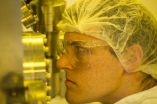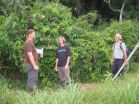(Press-News.org) An ultra-fast and ultra-small optical switch has been invented that could advance the day when photons replace electrons in the innards of consumer products ranging from cell phones to automobiles.
The new optical device can turn on and off trillions of times per second. It consists of individual switches that are only one five-hundredths the width of a human hair (200 nanometers) in diameter. This size is much smaller than the current generation of optical switches and it easily breaks one of the major technical barriers to the spread of electronic devices that detect and control light: miniaturizing the size of ultrafast optical switches.
The new device was developed by a team of scientists from Vanderbilt University, University of Alabama-Birmingham, and Los Alamos National Laboratory and is described in the Mar. 12 issue of the journal Nano Letters.
The ultrafast switch is made out of an artificial material engineered to have properties that are not found in nature. In this case, the "metamaterial" consists of nanoscale particles of vanadium dioxide (VO2) – a crystalline solid that can rapidly switch back and forth between an opaque, metallic phase and a transparent, semiconducting phase – which are deposited on a glass substrate and coated with a "nanomesh" of tiny gold nanoparticles.
The scientists report that bathing these gilded nanoparticles with brief pulses from an ultrafast laser generates hot electrons in the gold nanomesh that jump into the vanadium dioxide and cause it to undergo its phase change in a few trillionths of a second.
"We had previously triggered this transition in vanadium dioxide nanoparticles directly with lasers and we wanted to see if we could do it with electrons as well," said Richard Haglund, Stevenson Professor of Physics at Vanderbilt, who led the study. "Not only does it work, but the injection of hot electrons from the gold nanoparticles also triggers the transformation with one fifth to one tenth as much energy input required by shining the laser directly on the bare VO2."
Both industry and government are investing heavily in efforts to integrate optics and electronics, because it is generally considered to be the next step in the evolution of information and communications technology. Intel, Hewlett-Packard and IBM have been building chips with increasing optical functionality for the last five years that operate at gigahertz speeds, one thousandth that of the VO2 switch.
"Vanadium dioxide switches have a number of characteristics that make them ideal for optoelectronics applications," said Haglund. In addition to their fast speed and small size, they:
Are completely compatible with current integrated circuit technology, both silicon-based chips and the new "high-K dielectric" materials that the semiconductor industry is developing to continue the miniaturization process that has been a major aspect of microelectronics technology development;
Operate in the visible and near-infrared region of the spectrum that is optimal for telecommunications applications;
Generate an amount of heat per operation that is low enough so that the switches can be packed tightly enough to make practical devices: about ten trillionths of a calorie (100 femtojoules) per bit.
"Vanadium dioxide's amazing properties have been known for more than half a century. At Vanderbilt, we have been studying VO2 nanoparticles for the last ten years, but the material has been remarkably successfully at resisting theoretical explanations," said Haglund. "It is only in the last few years that intensive computational studies have illuminated the physics that underlies its semiconductor-to-metal transition."
Vanderbilt graduate students Kannatassen Appavoo and Joyeeta Nag fabricated the metamaterial at Vanderbilt; Appavoo joined forces with University of Alabama, Birmingham graduate student Nathaniel Brady and Professor David Hilton to carry out the ultrafast laser experiments with the guidance of Los Alamos National Laboratory staff scientist Rohit Prasankumar and postdoctoral scholar Minah Seo. The theoretical and computational studies that helped to unravel the complex mechanism of the phase transition at the nanoscale were carried out by postdoctoral student Bin Wang and Sokrates Pantelides, University Distinguished Professor of Physics and Engineering at Vanderbilt.
INFORMATION:
The university researchers were supported by Defense Threat-Reduction Agency grant HDTRA1-0047, U.S. Department of Energy grant DE-FG02-01ER45916, U.S. Department of Education GAANN Fellowship P200A090143 and National Science Foundation grant DMR-1207241. Portions of the research were performed at the Vanderbilt Institute of Nanoscale Science and Engineering in facilities renovated with NSF grant ARI-R2 DMR-0963361, at the Center for Integrated Nanotechnologies at Los Alamos National Laboratory under USDOE contract DE-AC52-06NA25396) and at Sandia National Laboratories under USDOE contract DE-AC04-94AL85000).
Nanoscale optical switch breaks miniaturization barrier
2014-03-13
ELSE PRESS RELEASES FROM THIS DATE:
CU-Boulder-led study on lunar crater counting shows crowdsourcing is accurate tool
2014-03-13
If Galileo was still alive and kicking, he might want to take a selfie with some of the thousands of citizen scientists all around the world for their surprisingly accurate work of counting craters on the pock-marked moon.
A new study led by the University of Colorado Boulder showed that as a group, volunteer counters who examined a particular patch of lunar real estate using NASA images did just as well in identifying individual craters as professional crater counters with five to 50 years of experience. And Galileo, who was observing the craters some 400 years ago with ...
Bioscientists develop 'grammar' to design useful synthetic living systems
2014-03-13
Researchers at Virginia Tech and the Massachusetts Institute of Technology have used a computer-aided design tool to create genetic languages to guide the design of biological systems.
Known as GenoCAD, the open-source software was developed by researchers at the Virginia Bioinformatics Institute at Virginia Tech to help synthetic biologists capture biological rules to engineer organisms that produce useful products or health-care solutions from inexpensive, renewable materials.
GenoCAD helps researchers in the design of protein expression vectors, artificial gene networks, ...
Fish species unique to Hawaii dominate deep coral reefs in Northwestern Hawaiian Islands
2014-03-13
Deep coral reefs in Papahanaumokuakea Marine National Monument (PMNM) may contain the highest percentage of fish species found nowhere else on Earth, according to a study by NOAA scientists published in the Bulletin of Marine Science. Part of the largest protected area in the United States, the islands, atolls and submerged habitats of the Northwestern Hawaiian Islands (NWHI) harbor unprecedented levels of biological diversity, underscoring the value in protecting this area, scientists said.
Hawaii is known for its high abundance of endemic species – that is, species ...
Plant biology discovery furthers scientists' understanding of plant growth and development
2014-03-13
RIVERSIDE, Calif. — Auxin, a small molecule, is a plant hormone discovered by Charles Darwin about 100 years ago. Over the years that followed it became understood to be the most important and versatile plant hormone controlling nearly all aspects of plant growth and development, such as bending of shoots toward the source of light (as discovered by Darwin), formation of new leaves, flowers, and roots, growth of roots, and gravity-oriented growth. Just how a small molecule like auxin could play such a pivotal role in plants baffled plant biologists for decades.
Then, ...
Mid-level solar flare seen by NASA's SDO
2014-03-13
The sun emitted a mid-level solar flare, peaking at 6:34 p.m. EDT on March 12, 2014, and NASA's Solar Dynamics Observatory, or SDO, captured an image of it. Solar flares are powerful bursts of radiation. Harmful radiation from a flare cannot pass through Earth's atmosphere to physically affect humans on the ground, however -- when intense enough -- they can disturb the atmosphere in the layer where GPS and communications signals travel.
To see how this event may impact Earth, please visit NOAA's Space Weather Prediction Center at http://spaceweather.gov, the U.S. government's ...
Halting immune response could save brain cells after stroke
2014-03-13
MADISON — A new study in animals shows that using a compound to block the body's immune response greatly reduces disability after a stroke.
The study by scientists from the University of Wisconsin School of Medicine and Public Health also showed that particular immune cells – CD4+ T-cells produce a mediator, called interleukin (IL) -21 that can cause further damage in stroke tissue. Moreover, normal mice, ordinarily killed or disabled by an ischemic stroke, were given a shot of a compound that blocks the action of IL-21. Brain scans and brain sections showed that the ...
Condon publishes new research in Science
2014-03-13
A wasp's sting might explain it all.
Marty Condon, professor of biology at Cornell College, has been studying flies in the tropics for years, and in a paper published in Science this week, she reports evidence that there is more to a fly's ecological niche than where it lives and what it eats—you have to look at what eats the fly, as well.
In a previous Science paper, Condon and her co-researchers found that there were far more species of flies feeding on tropical flowers than expected. It was counter-intuitive, Condon said, to see so many species of flies filling what ...
Scripps Florida scientists devise new, lower cost method to create more usable fuels
2014-03-13
JUPITER, FL – March 13, 2014 – As the United States continues to lead the world in the production of natural gas, scientists from the Florida campus of The Scripps Research Institute (TSRI) have devised a new and more efficient method with the potential to convert the major components found in natural gas into useable fuels and chemicals—opening the door to cheaper, more abundant energy and materials with much lower emissions.
The research, which was led by TSRI Professor Roy Periana, uses clever chemistry and nontraditional materials to turn natural gas into liquid ...
Scripps Research Institute scientists discover a better way to make unnatural amino acids
2014-03-13
LA JOLLA, CA—March 13, 2014—Chemists at The Scripps Research Institute (TSRI) have devised a greatly improved technique for making amino acids not found in nature. These "unnatural" amino acids traditionally have been very difficult to synthesize, but are sought after by the pharmaceutical industry for their potential medical uses.
"This new technique offers a very quick way to prepare unnatural amino acids, many of which are drug candidates or building blocks for peptide drugs," said Jin-Quan Yu, a professor in TSRI's Department of Chemistry.
Yu's team has reported ...
Scientists find new way to upgrade natural gas
2014-03-13
America's current energy boom may take a new direction thanks to the discovery of a new way to turn raw natural gas into upgraded liquid alcohol fuel.
In the March 14 issue of Science magazine, chemists from Brigham Young University and The Scripps Research Institute detail a process that could reduce dependence on petroleum.
The most unexpected breakthrough in the paper was that ordinary "main group" metals like thallium and lead can trigger the conversion of natural gas to liquid alcohol. The research teams saw in experiments that natural gas to alcohol conversion ...






